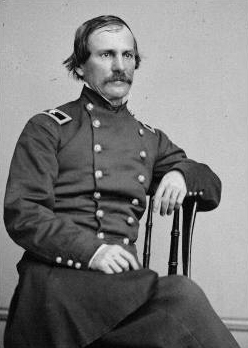William Hays (general) facts for kids
Quick facts for kids
William Hays
|
|
|---|---|

William Hays
|
|
| Born | May 9, 1819 Richmond, Virginia |
| Died | February 7, 1875 (aged 55) Boston, Massachusetts |
| Place of burial |
West Point Cemetery
|
| Allegiance | United States of America Union |
| Service/ |
United States Army Union Army |
| Years of service | 1840–1875 |
| Rank | |
| Commands held | Horse Artillery Brigade II Corps |
| Battles/wars | Mexican–American War American Civil War |
William Hays was an important officer in the United States Army who became a general during the American Civil War. He was born on May 9, 1819, and passed away on February 7, 1875. He spent his whole career serving his country.
Contents
Early Life and Military Training
Hays was born in Richmond, Virginia, but later moved to Nashville, Tennessee. He was chosen by President Andrew Jackson to attend the United States Military Academy. He graduated in 1840. Some of his classmates who also became famous generals were William T. Sherman and George H. Thomas.
After graduating, Hays started as a second lieutenant. This was a "brevet" rank, meaning it was a temporary higher rank given for good service. He was promoted to first lieutenant in 1847. During these early years, he served at different military bases in the northeastern United States.
Serving in the Mexican-American War
Hays fought in the Mexican–American War as part of the light artillery. Artillery units use large guns, like cannons. He served alongside Henry J. Hunt, who would also become a famous artillery officer in the Civil War.
Hays was injured during the Battle of Molino del Rey. For his bravery in other battles, like Contreras, Churubusco, and Chapultepec, he received temporary promotions to captain and then major. After the war, in 1853, he was officially promoted to captain. He then served in the Seminole Wars in Florida and later on frontier duty, which meant serving at military posts in less settled areas of the country.
Civil War Service
When the American Civil War began, Hays was a lieutenant colonel. He led a special unit called a horse artillery brigade. These units had cannons that could be moved quickly by horses. He served under Henry Hunt in the Army of the Potomac. Hays and his unit performed well at the Battle of Seven Pines during the Peninsula Campaign.
Key Battles and Commands
Hays also took part in the Battle of Antietam. Here, he commanded the V Corps Reserve Artillery. His cannons were placed on high ground, firing at Confederate soldiers from a distance. He also led the artillery for a large part of the Union army at the Battle of Fredericksburg.
In November 1862, Hays was promoted to brigadier general. He was then given command of an infantry brigade, which is a group of foot soldiers, within the II Corps.
Capture and Return to Duty
During the Battle of Chancellorsville on May 3, 1863, General Hays was wounded and captured by Confederate forces. Most of his staff, who were his assistants, were also captured.
Hays was released on May 15, 1863. He then went to Fort Monroe in Virginia. Even though he didn't have an official command yet, he rejoined the Army of the Potomac and went with them to Gettysburg, Pennsylvania.
Commanding the II Corps at Gettysburg
At the Battle of Gettysburg, during a famous attack called Pickett's Charge on July 3, Maj. Gen. Winfield S. Hancock was badly wounded. Hancock temporarily gave command of the II Corps to General Hays. Even though Hays was a brigadier general and usually lower in rank than some other officers, he was chosen to lead the corps. He commanded the II Corps for the rest of the summer.
In November, Hays was made the provost marshal for the southern district of New York. A provost marshal is like a military police chief, responsible for maintaining order. He was also promoted to major in the regular army.
End of the War
In February 1865, Hays rejoined the Army of the Potomac at Petersburg. He again served in the II Corps, this time leading the 2nd Division. He received another temporary promotion to brigadier general for his brave actions. However, on April 6, he was removed from command because he was found sleeping on duty. This meant his troops were not ready to move when they needed to pursue Confederate forces. His temporary promotions were taken away. After this, Hays commanded the Artillery Reserve of the Army of the Potomac until he left volunteer service in January 1866.
Later Life
After the Civil War, William Hays returned to his permanent rank of major in the 5th U.S. Artillery. He served at various military posts. From April 1873 until his death, he commanded Fort Independence in Boston Harbor. He passed away there on February 7, 1875. He was first buried in Yonkers, New York, but his remains were later moved to West Point Cemetery in 1894.

